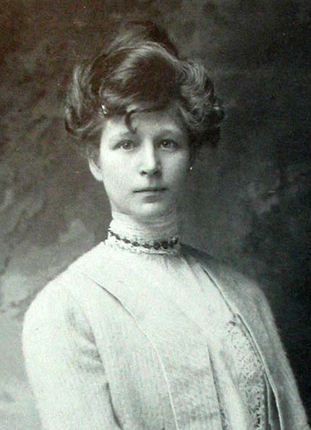

Husband D.H. Lawrence
 Frieda
Lawrence (August 11, 1879 – August 11, 1956), born Frieda Freiin[note
1] von Richthofen, was a German literary figure mainly known for her
marriage to the British novelist
D. H. Lawrence. She
was a distant relation of Manfred von Richthofen, the "Red Baron".
Frieda
Lawrence (August 11, 1879 – August 11, 1956), born Frieda Freiin[note
1] von Richthofen, was a German literary figure mainly known for her
marriage to the British novelist
D. H. Lawrence. She
was a distant relation of Manfred von Richthofen, the "Red Baron".
Emma Maria Frieda Johanna Freiin (Baroness) von Richthofen (also known as Frieda Weekley, Frieda Lawrence, and Frieda Lawrence Ravagli) was born in Metz. Her father was Baron Friedrich Ernst Emil Ludwig von Richthofen (1844–1916), an engineer in the German army, and her mother was Anna Elise Lydia Marquier (1852–1930). She was a fifth cousin, once removed, of German air ace Manfred von Richthofen. Though their last common ancestor was born in 1661, the Red Baron's fame nonetheless attached to Frieda's reputation in wartime England.
In 1899, she married a British philologist and professor of modern languages, Ernest Weekley, with whom she had three children, Charles Montague (born 1900), Elsa Agnès (born 1902) and Barbara Joy (born 1904). They settled in Nottingham, where Ernest worked at the university. During her marriage to Weekley she started to translate German literature, mainly fairy tales, into English.
In 1912, she met D. H. Lawrence, a former student of her husband. She soon fell in love with him and the pair eloped to Germany, Frieda leaving her children behind. During their stay, Lawrence was arrested for spying and, after the intervention of Frieda's father, the couple walked south, over the Alps to Italy. Following her divorce from Weekley, Frieda and Lawrence married in 1914. They intended to return to the continent, but the outbreak of war kept them in England, where they endured official harassment and censorship. They also struggled with limited resources and D. H. Lawrence's already frail health.
Leaving post-war England at the earliest opportunity, they travelled widely, eventually settling at the Kiowa Ranch (now D. H. Lawrence Ranch) near Taos, New Mexico (donated to them by Mabel Dodge Luhan) and, in Lawrence's last years, at the Villa Mirenda, near Scandicci in Tuscany. After her husband's death in Vence, France in 1930, she returned to Taos to live with her third husband, Angelo Ravagli. The ranch is now owned by the University of New Mexico at Albuquerque.
Georgia O'Keeffe, who knew her in Taos, said in 1974: “Frieda was very special. I can remember very clearly the first time I ever saw her, standing in a doorway, with her hair all frizzed out, wearing a cheap red calico dress that looked as though she’d just wiped out the frying pan with it. She was not thin, and not young, but there was something radiant and wonderful about her." [1]
Mainly through her elder sister Else von Richthofen, Frieda became acquainted with many intellectuals and authors, including the socioeconomist Alfred Weber and sociologist Max Weber, the radical psychoanalyst Otto Gross (who became her lover), and the writer Fanny zu Reventlow.
By her approving the dramatization for the theatre of Lawrence's Lady Chatterley's Lover—thought to be based partly on her own relationship as an aristocrat with the working class Lawrence—it became his only novel ever to be staged. John Harte's play was the only dramatization to be accepted by her, and she did her best to get it produced. Although she loved the play when she read it, the copyright to Lawrence's story had already been acquired by Baron Philippe de Rothschild, who was a close friend. He did not relinquish it until 1960. John Harte's play was first produced at The Arts Theatre in 1961, five years after her death.
Frieda Lawrence died on her 77th birthday in Taos.
My published books: